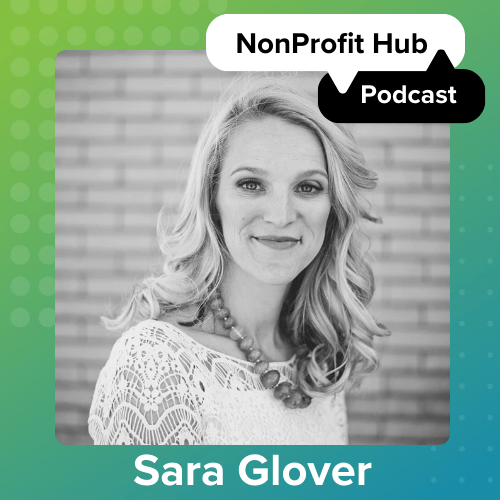Offer various donation options through ecommerce
Collecting donations is one of the main sources of funding for many nonprofit organizations. That’s why, when looking into ecommerce platforms for your website, find one that allows you to collect donations. Make “Donate” buttons bright and easy to find on your website. It doesn’t hurt to add them to every website page. This way, visitors don’t lose sight of it and can donate from any page they’re browsing. Let’s look at some of the different donation types you can use with an ecommerce platform.
Collect one-time donations
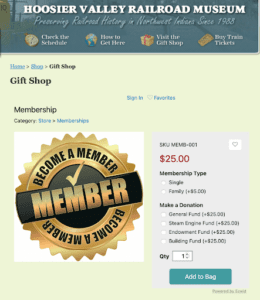 One-time donations are great for attracting the attention of first-time website visitors. They also benefit people who aren’t ready to subscribe to regular donations yet. One-time donations can be added as a separate option on your website, or as an add-on to a product or service. For example, Hoosier Valley Railroad Museum allows customers to donate to different targeted funds when they purchase a membership in their gift shop. When it comes to one-time donations, set up fixed price tiers for donating or let site visitors decide on their own donation amount.
One-time donations are great for attracting the attention of first-time website visitors. They also benefit people who aren’t ready to subscribe to regular donations yet. One-time donations can be added as a separate option on your website, or as an add-on to a product or service. For example, Hoosier Valley Railroad Museum allows customers to donate to different targeted funds when they purchase a membership in their gift shop. When it comes to one-time donations, set up fixed price tiers for donating or let site visitors decide on their own donation amount.
Collect recurring donations
Recurring revenue is extremely important for nonprofits. It allows you to budget more accurately and make running your nonprofit a more predictable and sustainable venture. Here’s how recurring donations work: a person subscribes to donate a certain amount weekly, bi-weekly, monthly, or annually. Then they are automatically charged that amount on a regular basis. Apart from being billed regularly, nonprofit supporters can still choose other ways to donate on an ongoing basis. There are memberships or sponsorships that provide interested donors with bonuses for recurring donations.
 Chase Animal Rescue Sanctuary allows website visitors to sponsor an animal, for example. They can choose which animal to support and how much money they want to donate monthly. Sponsors are then automatically charged the same amount each month. As a perk, the sanctuary sponsors get monthly updates on their animals, including pictures. Depending on the sponsorship level, some supporters also get free admission for a tour or sanctuary merchandise.
Chase Animal Rescue Sanctuary allows website visitors to sponsor an animal, for example. They can choose which animal to support and how much money they want to donate monthly. Sponsors are then automatically charged the same amount each month. As a perk, the sanctuary sponsors get monthly updates on their animals, including pictures. Depending on the sponsorship level, some supporters also get free admission for a tour or sanctuary merchandise.
When you collect recurring donations, it’s essential to keep your supporters in the loop. Think about sending regular newsletters to people who have subscribed to regular contributions. Thank them and tell them about the amazing things their donations have allowed you to do. In addition, use a newsletter to share your nonprofit’s news and plans, announce events, and outline new ways to support your organization.
Add a donation option at checkout
If you have an online store to sell your nonprofit-related products and services, don’t forget to add a donation option to your checkout. Offer your customers predefined donation amount options in either fixed sum amounts or as a percentage of the order total. You can also pre-select a donation amount for your customers that will be automatically added to orders at checkout. In this case, be sure to enable the “No tip” option to let customers check out with no donation as well.
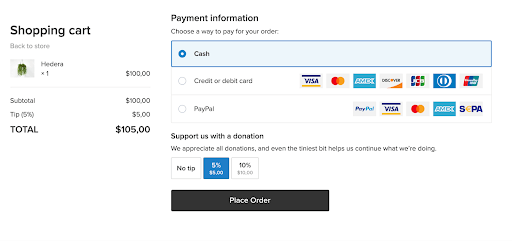
Grow your funding with an online ecommerce store
Adding an online store to your nonprofit’s website can drastically grow your funding. Why? Because it encourages interested visitors to take action instead of just browsing your website. Having an online store streamlines the process of donating. Visitors can easily support your nonprofit in a couple of clicks, instead of having to research other ways to support your cause or make a bank transfer.
For maximum flexibility, you can also enable a “Pay What You Want” price for some products so that customers can choose to round up their payment amount. This way, they can choose to support your nonprofit just by adding on a couple of dollars to their total, instead of having to make a separate donation at checkout. Adding a minimum price to this option helps ensure you won’t get less money for a product than it costs. At the same time, “Pay What You Want” encourages customers to be charitable without going out of their way to do so.
Here are a few other ways to use your nonprofit’s online store.
Use ecommerce to sell your merchandise
There are various items that nonprofits can sell as branded merchandise. Popular choices include mugs, hats, t-shirts, posters, hoodies, phone cases, tote bags, face masks, key chains, soft toys, and more. To create your branded merchandise, print your nonprofit’s logo, slogan, or custom-designed image on products. For example, LaLaLand, a cafe with the purpose of hiring foster youth, offers a wide variety of branded products in their online store. These include clothes, accessories, mugs, and bottles with their brand logo, slogan, and custom images.

However, creating custom-designed products takes extra time and money—two things nonprofits usually don’t have to spare. In this case, you might want to connect your online store to print-on-demand services. They take care of sourcing inventory, storing it, printing and shipping orders to customers. Here’s how it works: a customer buys a hat with your nonprofit logo in your online store. The order is automatically sent to a print-on-demand service. It prints your logo on a hat and sends the order to the customer. The benefits of using print-on-demand services are obvious: you don’t need to source and store inventory and deal with printing and shipping. And because the products are made on-demand, there’s no risk of dead stock.
Branded merchandise is not always about products with printed logos or images. Some nonprofits get creative with the merchandise they offer to make it truly unique. For example, Helping Rhinos, a rhino charity, sells Rhino Tear jewelry: pendants, cuffs, bangles, and earrings in the form of a tear. All profits from jewelry sales go to anti-poaching projects across Africa.

Sell event tickets
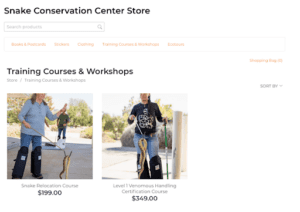 If your nonprofit hosts paid events such as workshops, classes, courses, or panel discussions, you can sell tickets to those events in your online store. Save the Snakes, a nonprofit dedicated to snake conservation and human-snake conflict mitigation, sells training courses and workshops on their website. Customers can choose the date of a workshop when placing their online order.
If your nonprofit hosts paid events such as workshops, classes, courses, or panel discussions, you can sell tickets to those events in your online store. Save the Snakes, a nonprofit dedicated to snake conservation and human-snake conflict mitigation, sells training courses and workshops on their website. Customers can choose the date of a workshop when placing their online order.
Sell educational resources
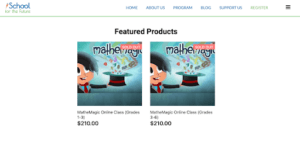 Education-based nonprofits and other organizations can benefit from an online store if they produce various resources. This works for both physical and digital resources—books, guides, checklists, or brochures. Online classes and courses are also a common product for nonprofits. For example, iSchool for the Future, an educational nonprofit, sells online classes on their website. The link with instructions and resources is emailed to customers upon purchase.
Education-based nonprofits and other organizations can benefit from an online store if they produce various resources. This works for both physical and digital resources—books, guides, checklists, or brochures. Online classes and courses are also a common product for nonprofits. For example, iSchool for the Future, an educational nonprofit, sells online classes on their website. The link with instructions and resources is emailed to customers upon purchase.
Sell gift cards
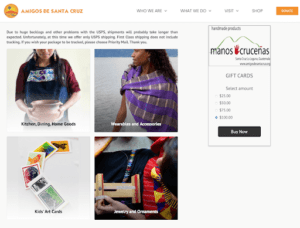 Apart from selling merchandise, event tickets, or resources, nonprofits can also add gift cards to their online store. This provides another option to support a nonprofit since it encourages customers to draw others’ attention to the cause they care about. A gift card for a program or resource can be purchased as a birthday or holiday gift, for example. Check out how Amigos de Santa Cruz put gift cards front-and-center for their online store. The “Buy Now” button is visible on every page of the store: the storefront, category pages, and even product pages. This nonprofit supports indigenous Mayan women artisans from Santa Cruz. All proceeds from the store directly benefit artisans and their families.
Apart from selling merchandise, event tickets, or resources, nonprofits can also add gift cards to their online store. This provides another option to support a nonprofit since it encourages customers to draw others’ attention to the cause they care about. A gift card for a program or resource can be purchased as a birthday or holiday gift, for example. Check out how Amigos de Santa Cruz put gift cards front-and-center for their online store. The “Buy Now” button is visible on every page of the store: the storefront, category pages, and even product pages. This nonprofit supports indigenous Mayan women artisans from Santa Cruz. All proceeds from the store directly benefit artisans and their families.
***
Some people prefer donating. Others like wearing merchandise that highlights the cause they support. But no matter what charitable method is more popular for your nonprofit, an ecommerce store is a great way to let people support you in a convenient way. Whether you offer a donation button or a Pay What You Want feature, make sure to also have a “How You Can Help” page or tab on your website. Use it as a space where you can list all the ways people can support your cause: by donating, volunteering, buying merchandise or other products, sharing your nonprofit website on their social media pages, and so on.
If you’d like to test an online store for your nonprofit, there are a number of free ecommerce platform options available. For example, Ecwid has a Forever Free plan that allows you to set up a free one-page ecommerce website, sell up to ten products, and collect one-time donations. Paid plans provide tools for collecting recurring donations as well as easy integration with print-on-demand services.




